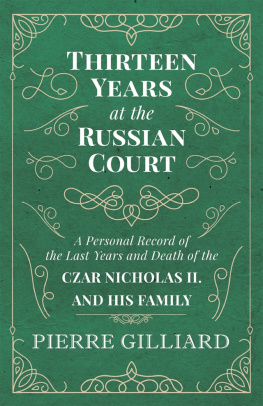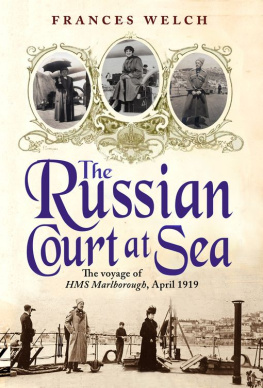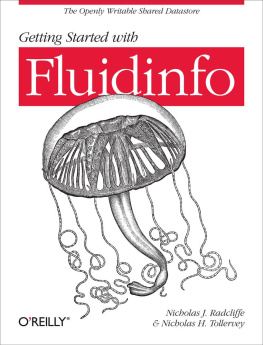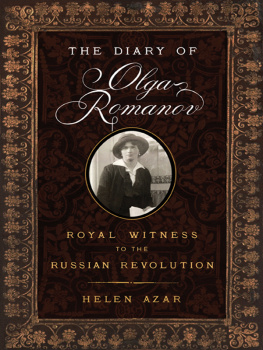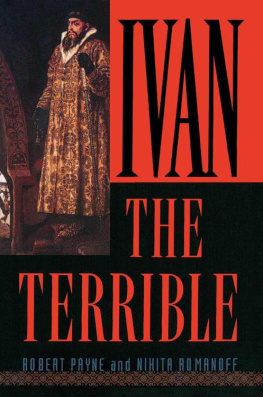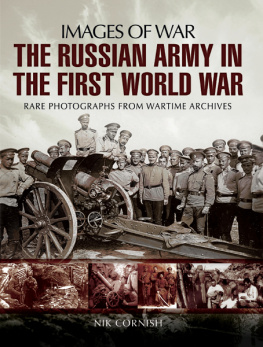INTRODUCTION
IN September, 1920, after staying three years in Siberia, I was able to return to Europe. My mind was still full of the poignant drama with which I had been closely associated, but I was also still deeply impressed by the wonderful serenity and flaming faith of those who had been its victims.
Cut off from communication with the rest of the world for many months, I was unfamiliar with recent publications on the subject of the Czar Nicholas II. and his family. I was not slow to discover that though some of these works revealed a painful anxiety for accuracy and their authors endeavoured to rely on serious records (although the information they gave was often erroneous or incomplete so far as the Imperial family was concerned), the majority of them were simply a tissue of absurdities and falsehoodsin other words, vulgar outpourings exploiting the most unworthy calumnies.
I was simply appalled to read some of them. But my indignation was far greater when I realised to my amazement that they had been accepted by the general public.
To rehabilitate the moral character of the Russian sovereigns was a dutya duty called for by honesty and justice. I decided at once to attempt the task.
What I am endeavouring to describe is the drama of a lifetime, a drama I (at first) suspected under the brilliant exterior of a magnificent Court, and then realised personally during our captivity when circumstances brought me into intimate contact with the sovereigns. The Ekaterinburg drama was, in fact, nothing but the fulfilment of a remorseless destiny, the climax of one of the most moving tragedies humanity has known. In the following pages I shall try to show its nature and to trace its melancholy stages.
There were few who suspected this secret sorrow, yet it was of vital importance from a historical point of view. The illness of the Czarevitch cast its shadow over the whole of the concluding period of the Czar Nicholas II.s reign and alone can explain it. Without appearing to be, it was one of the main causes of his fall, for it made possible the phenomenon of Rasputin and resulted in the fatal isolation of the sovereigns who lived in a world apart, wholly absorbed in a tragic anxiety which had to be concealed from all eyes.
In this book I have endeavoured to bring Nicholas II. and his family back to life. My aim is to be absolutely impartial and to preserve complete independence of mind in describing the events of which I have been an eyewitness. It may be that in my search for truth I have presented their political enemies with new weapons against them, but I greatly hope that this book will reveal them as they really were, for it was not the glamour of their Imperial dignity which drew me to them, but their nobility of mind and the wonderful moral grandeur they displayed through all their sufferings.
PIERRE GILLIARD.
To give some idea of what I mean, it is only necessary to record that in one of these books (which is based on the evidence of an eyewitness of the drama of Ekaterinburg, the authenticity of which is guaranteed) there is a description of my death! All the rest is on a par.
Everyone desiring information about the end of the reign of Nicholas II. should read the remarkable articles recently published in the Revue des Deux Mondes by M. Paleologue, the French Ambassador at Petrograd.
LIST OF ILLUSTRATIONS
The Czar clearing snow at Tsarskoe-Selo
The Czarevitch in the park of Tsarskoe-Selo
The four Grand-Duchesses in 1909
The Czarina before her marriage
The Czarevitch at the age of fifteen months
The Grand-Duchesses Marie and Anastasie in theatrical costume
The Czarina at the Czarevitchs bedside
The four Grand-Duchesses gathering mushrooms
The Czarevitch cutting corn he had sown at Peterhof
Letter to the author from the Grand-Duchess Olga Nicolaevna, 1914
The Czarevitch with his dog Joy
The Czarina and the Czarevitch in the court of the palace at Livadia
The Czarina sewing in the Grand-Duchesses room
Excursion to the Red Rock on May 8th, 1914
The four Grand-Duchesses, 1914
The Czar and Czarevitch examining a captured German machine-gun, 1914
The Czar and Czarevitch before the barbed wire, 1915
The Czar
The Czarevitch
The Czarina
The four Grand-Duchesses
The Czar and Czarevitch on the banks of the Dnieper, 1916
The Czar and Czarevitch near Mohileff, 1916
The Czar and Czarevitch at a religious service at G.H.Q., Mohileff
The Grand-Duchesses visiting the family of a railway employee
The Czarina and Grand-Duchess Tatiana talking to refugees
The Grand-Duchess Marie as a convalescent
The four Grand-Duchesses in the park at Tsarskoe-Selo
The Czarinas room in the Alexander Palace
The Portrait Gallery
The Czar, his children and their companions in captivity working in the park
The Czar working in the kitchen-garden
The Czarina, in an invalid chair, working at some embroidery
The Grand-Duchess Tatiana carrying turf
The Czar and his servant Juravsky sawing the trunk of a tree
The Grand-Duchessses Tatiana and Anastasie taking a water-butt to the kitchen-garden
The Imperial familys suite at Tsarskoe-Selo, 1917
The Grand-Duchess Tatiana a prisoner in the park of Tsarskoe-Selo
Alexis Nicolaevitch joins the Grand-Duchess
The Czar and his children in captivity enjoying the sunshine at Tobolsk
The Governors house at Tobolsk, where the Imperial family were interned
The Czar sawing wood with the author
Alexis Nicolaevitch on the steps of the Governors house
The Imperial family at the main door of the Governors house
The Czarinas room
The priest celebrating Mass in the Governors house after the departure of Their Majesties
The river steamer Rouss on which the Czar and his family travelled
Ipatiefs house at Ekaterinburg, in which the Imperial family were interned and subsequently massacred
Yourovsky, from a photograph produced at the enquiry
The Grand-Duchesses room in Ipatiefs house
Ipatiefs house from the Vosnessensky street
The Czarinas favourite lucky charm, the Swastika
The room in Ipatiefs house in which the Imperial family and their companions were put to death
Mine-shaft where the ashes were thrown
The search in the mine-shaft

